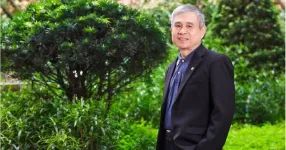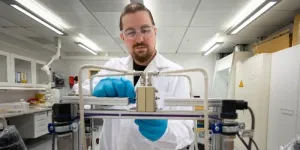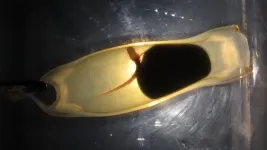(Press-News.org) In the decade since their discovery at Drexel University, the family of two-dimensional materials called MXenes has shown a great deal of promise for applications ranging from water desalination and energy storage to electromagnetic shielding and telecommunications, among others. While researchers have long speculated about the genesis of their versatility, a recent study led by Drexel and the University of California, Los Angeles, has provided the first clear look at the surface chemical structure foundational to MXenes’ capabilities.
Using advanced imaging techniques, known as scanning tunneling microscopy (STM) and scanning tunneling spectroscopy (STS), the team, which also includes researchers from California State University Northridge, and Lawrence Berkeley National Laboratory, mapped the electrochemical surface topography of the titanium carbide MXene — the most-studied and widely used member of the family. Their findings, published in the 5th anniversary issue of the Cell Press journal Matter, will help to explain the range of properties exhibited by members of the MXene family and allow researchers to tailor new materials for specific applications.
“Much of MXenes’ potential results from their rich surface chemistry,” said Yury Gogotsi, PhD, Distinguished University and Bach professor in Drexel’s College of Engineering, a lead author of the research, whose research group participated in the materials’ discovery in 2011. “Getting the first atomic-scale look at their surface, using scanning tunneling microscopy, is an exciting development that will open new possibilities for controlling the material surface and enabling applications of MXenes in advanced technologies.”
Although MXenes are two-dimensional materials, the interaction that is the basis of their chemical, electrochemical, and catalytic properties — whether it’s ultrafast storage of electrical energy, splitting water to produce hydrogen, or skimming urea out of blood — is initiated by the atoms that form their surface layer.
Previous research has provided a lower-resolution looks at the chemical structure of MXene surfaces, using technology such as scanning electron microscopy (SEM), secondary ion mass spectroscopy (SIMS) and tip-enhanced Raman spectroscopy (TERS). These tools offer indirect readings of the material’s composition, but provide little information about the intricacies of its surface organization.
Scanning tunneling microscopy and scanning tunneling spectroscopy, by contrast, provide more direct information about the shape and composition of a material’s surface structure, as well as its surface chemistry and properties.
These tools use an extremely sharp probe, sensitive enough to distinguish one atom from another as it scans across a flat surface. The tip of the probe carries an electric charge that enables it to interact with each atom as it passes by, this interaction — called quantum tunneling — provides information about the atoms on the surface of the material. Spectroscopic scans provide information about surface composition at the atomic and molecular levels. The scans are converted into images, forming topographical maps of the material’s surface.
“With STM/STS, we can see atomic arrangements on MXenes’ surface and even study their conductance with atomic resolution,” Gogotsi said. “This is the key to understanding why MXenes have extreme properties and outperform other materials in many applications. It should also help us to explore quantum properties of MXenes and identify new opportunities for this quickly expanding family of materials.”
Locating groups of atoms — called functional groups — identifying them and measuring their properties on the surface, given their specific location and attachment, are all important developments for understanding how MXenes interact with other chemicals and materials, according to the researchers.
“The MXene surfaces are chemically heterogeneous. That is both what makes them interesting and what makes them difficult to study,” said Paul Weiss, PhD, a distinguished professor and UC Presidential chair at UCLA who led the research with Gogotsi. “We believe that it is also key to their amazing properties. However, we do not yet know which chemical functionalities are important for which applications.”
The group’s STM/STS imaging showed 10-nanometer features on the MXene’s surface, likely to be titanium oxide clusters, and smaller protrusions, arrayed in a distorted hexagonal symmetry, that they deemed to be functional groups, which they went on to identify chemically.
The results of this research were consistent with previous theories, lower-resolution microscopy and spectral data about the surface of titanium carbide MXenes, including the prediction that their surface is metallic. However, getting a closer look at the surface defects and the nature of its heterogeneity is an important step in understanding how they affect the material’s behavior, according to the team.
“In this work, we started pulling at the threads. We were able to image and to start to assign some of the chemical functionality,” Weiss said. “One of the most interesting unknown aspects of MXenes is what roles their defects and heterogeneity play in their function and environmental stability. We now have our foot in the door to explore these roles.”
Drawing on the collective expertise of Drexel’s materials scientists, the STM groups at UCLA and Lawrence Berkley National Laboratory, and theoretical scientists at Cal State Northridge, the group will continue its rigorous analysis of the materials as it lays out a process for modulating their chemical composition to tune their functionality for different uses.
END
Mapping the surfaces of MXenes, atom by atom, reveals new potential for the 2D materials
Drexel and UCLA researchers perform first scanning tunneling microscopy and spectroscopy inspection of 2D material with unique properties
2024-07-03
ELSE PRESS RELEASES FROM THIS DATE:
Mobile phone data helps track pathogen spread and evolution of superbugs
2024-07-03
A new way to map the spread and evolution of pathogens, and their responses to vaccines and antibiotics, will provide key insights to help predict and prevent future outbreaks. The approach combines a pathogen’s genomic data with human travel patterns, taken from anonymised mobile phone data.
Researchers from the Wellcome Sanger Institute, University of the Witwatersrand and National Institute for Communicable Diseases in South Africa, the University of Cambridge, and partners across the Global Pneumococcal Sequencing project1, integrated genomic data from nearly 7,000 Streptococcus pneumoniae (pneumococcus) samples collected in South Africa with detailed ...
Discovery of cellular mechanism to maintain brain’s energy could benefit late-life brain health
2024-07-03
A key mechanism which detects when the brain needs an additional energy boost to support its activity has been identified in a study in mice and cells led by UCL scientists.
The scientists say their findings, published in Nature, could inform new therapies to maintain brain health and longevity, as other studies have found that brain energy metabolism can become impaired late in life and contribute to cognitive decline and the development of neurodegenerative disease.
Lead author Professor Alexander Gourine (UCL Neuroscience, ...
Extinct humans survived on the Tibetan plateau for 160,000 years
2024-07-03
Bone remains found in a Tibetan cave 3,280 m above sea level indicate an ancient group of humans survived here for many millennia, according to a new study published in Nature.
The Denisovans are an extinct species of ancient human that lived at the same time and in the same places as Neanderthals and Homo sapiens. Only a handful Denisovan remains have ever been discovered by archaeologists. Little is known about the group, including when they became extinct, but evidence exists to ...
PolyU study reveals the mechanism of bio-inspired control of liquid flow, enlightening breakthroughs in fluid dynamics and nature-inspired materials technologies
2024-07-03
The more we discover about the natural world, the more we find that nature is the greatest engineer. Past research believed that liquids can only be transported in fixed direction on species with specific liquid communication properties and cannot switch the transport direction. Recently, The Hong Kong Polytechnic University (PolyU) researchers have shown that an African plant controls water movement in a previously unknown way – and this could inspire breakthroughs in a range of technologies in fluid dynamics and nature-inspired materials, including applications that require multistep and repeated reactions, such as microassays, medical ...
Early-onset El Niño means warmer winters in East Asia, and vice versa
2024-07-03
Fukuoka, Japan—The phenomenon known as El Niño can cause abnormal and extreme climate around the world due to it dramatically altering the normal flow of the atmosphere. In Japan, historical data has shown that El Niño years tend to lead to warmer winters. This case was exemplified recently with Japan’s warm 2023-2024 winter season. However, there have also been cases of cold winters in Japan during El Niño years, such as the one recorded in 2014-2015. Yet, it was unclear as to why this was occurring.
Publishing in the Journal of Climate, ...
How to avoid wasting huge amounts of energy
2024-07-03
Norway wastes huge amounts of energy. Surplus heat produced by industry is hardly exploited at all.
Researchers at the Norwegian University of Science and Technology (NTNU) have been looking at the possibilities for doing something about this.
“Surplus heat from industrial processes is a huge resource,” says Kim Kristiansen.
He has just completed his PhD on a technology that can harness some of the surplus heat that currently goes to waste. Almost all the heat generated by industrial processes is currently released directly into the air or the ocean, and we are not talking about small amounts. In Norway alone, industry produces ...
Bowel cancer turns genetic switches on and off to outwit the immune system
2024-07-03
Bowel cancer cells have the ability to regulate their growth using a genetic on-off switch to maximise their chances of survival, a phenomenon that’s been observed for the first time by researchers at UCL and University Medical Center Utrecht.
The number of genetic mutations in a cancer cell was previously thought to be purely down to chance. But a new study, published in Nature Genetics, has provided insights into how cancers navigate an “evolutionary balancing act”.
The researchers found that mutations in DNA repair genes can be repeatedly created and repaired, acting as ‘genetic switches’ that take the brakes off a tumour’s growth ...
Shark hatching success drops from 82% to 11% in climate change scenario
2024-07-03
New experimental research shows that the combined effects of ocean warming and acidification could lead to a catastrophic decrease in embryonic shark survival by the year 2100. This research is also the first to demonstrate that monthly temperature variation plays a prominent role in shark embryo mortality.
Oceanic warming and acidification are caused by greater concentrations of CO2 dissolving into marine environments, resulting in rising water temperatures and falling pH levels. “The embryos of egg-laying ...
Meet the team 3D modelling France’s natural history collections
2024-07-03
France’s natural history collections contain nearly 6% of the world’s total natural specimens across multiple institutions, and the e-COL+ project aims to capture and reconstruct these specimens in 3D for easy access and 3D printing around the world.
“I’m a researcher of vertebrate locomotion and vocalisation, so I produce a lot of CT scans and 3D models – and now I’m in charge of developing the museum’s own 3D digital collection,” ...
Artificial light is a deadly siren song for young fish
2024-07-03
New research finds that artificial light at night (ALAN) attracts larval fish away from naturally lit habitats, while dramatically lowering their chances of survival in an “ecological trap”, with serious consequences for fish conservation and fishing stock management.
“Light pollution is a huge ongoing subject with many aspects that are still not well understood by scientists,” says Mr Jules Schligler, a PhD student at CRIOBE Laboratory (Centre de Recherches Insulaires et Observatoire de l’Environnement) in Moorea, French Polynesia.
ALAN is the product of human-related ...
LAST 30 PRESS RELEASES:
Heart-brain connection: international study reveals the role of the vagus nerve in keeping the heart young
Researchers identify Rb1 as a predictive biomarker for a new therapeutic strategy in some breast cancers
Survey reveals ethical gaps slowing AI adoption in pediatric surgery
Stimulant ADHD medications work differently than thought
AI overestimates how smart people are, according to HSE economists
HSE researchers create genome-wide map of quadruplexes
Scientists boost cell "powerhouses" to burn more calories
Automatic label checking: The missing step in making reliable medical AI
Low daily alcohol intake linked to 50% heightened mouth cancer risk in India
American Meteorological Society announces Rick Spinrad as 2026 President-Elect
Biomass-based carbon capture spotlighted in newly released global climate webinar recording
Illuminating invisible nano pollutants: advanced bioimaging tracks the full journey of emerging nanoscale contaminants in living systems
How does age affect recovery from spinal cord injury?
Novel AI tool offers prognosis for patients with head and neck cancer
Fathers’ microplastic exposure tied to their children’s metabolic problems
Research validates laboratory model for studying high-grade serous ovarian cancer
SIR 2026 delivers transformative breakthroughs in minimally invasive medicine to improve patient care
Stem Cell Reports most downloaded papers of 2025 highlight the breadth and impact of stem cell research
Oxford-led study estimates NHS spends around 3% of its primary and secondary care budget on the health impacts of heat and cold in England
A researcher’s long quest leads to a smart composite breakthrough
Urban wild bees act as “microbial sensors” of city health.
New study finds where you live affects recovery after a hip fracture
Forecasting the impact of fully automated vehicle adoption on US road traffic injuries
Alcohol-related hospitalizations from 2016 to 2022
Semaglutide and hospitalizations in patients with obesity and established cardiovascular disease
Researchers ‘listen in’ to embryo-mother interactions during implantation using a culture system replicating the womb lining
How changing your diet could help save the world
How to make AI truly scalable and reliable for real-time traffic assignment?
Beyond fragmented markets: A new framework for efficient and stable ride-pooling
Can shape priors make road perception more reliable for autonomous driving?
[Press-News.org] Mapping the surfaces of MXenes, atom by atom, reveals new potential for the 2D materialsDrexel and UCLA researchers perform first scanning tunneling microscopy and spectroscopy inspection of 2D material with unique properties







